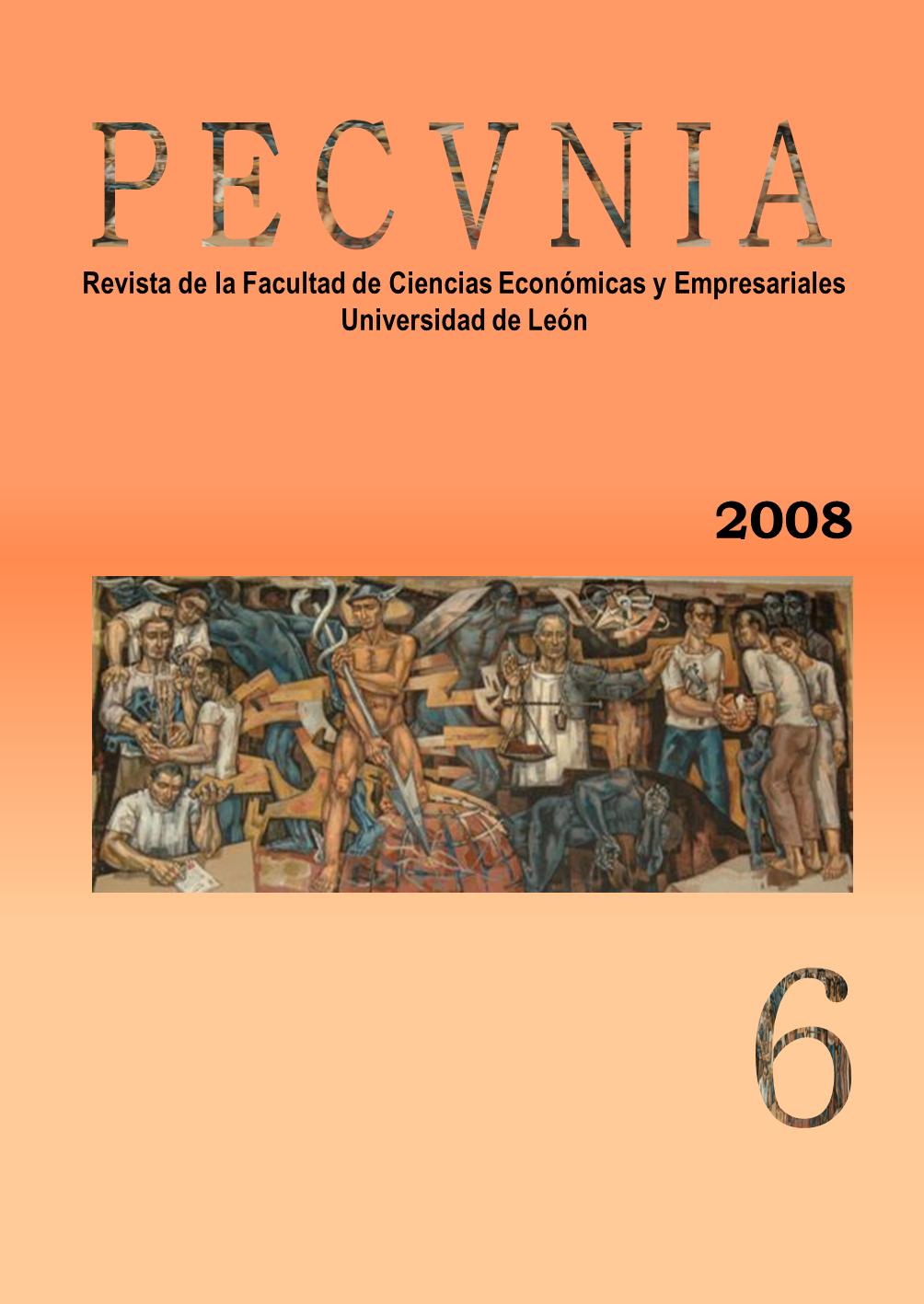¿Financian los franquiciados la expansión de los franquiciadores?: evidencia para el caso español.
DOI :
https://doi.org/10.18002/pec.v0i6.705Mots-clés :
Franquicia, Escasez de capital, Datos de panel, Evolución, Franchising, Capital scarcity, Panel data, EvolutionRésumé
Este trabajo tiene como objetivo analizar si la dificultad para acceder a los recursos financieros es un factor determinante de la propensión franquiciadora de las cadenas españolas. Para ello, se ha tomado como muestra un panel de datos formado por cadenas observadas entre 1996 y 2002. Además, empleamos un modelo dinámico de ajuste parcial de la estructura de propiedad de las cadenas utilizando el método generalizado de los momentos en primeras diferencias, lo que nos permite, no sólo introducir un componente autorregresivo, sino también el empleo de variables explicativas endógenas. Los resultados obtenidos muestran que cuanto mayor es la liquidez y la rentabilidad económica y menor es el endeudamiento de una determinada cadena menor es su propensión franquiciadora, lo que apoya el argumento financiero. Por el contrario, los requisitos de inversión necesarios para la expansión no son significativos. Además, la antigüedad presenta un signo contrario al previsto. Finalmente, observamos que se verifica el modelo de ajuste parcial de la estructura de propiedad, obteniendo una elevada velocidad de ajuste, entre un 78-69%.This work considers whether the difficulty for obtaining funding affects the choice of organizational form for franchise chains. We created a panel of Spanish franchisers who were observed from 1996 to 2002, and calculated a dynamic, partial-fit model for ownership structure, using the generalised method of moments in first differences. This allowed us to introduce auto-regression and to use endogenous explanatory variables. The results obtained show that the greater a chain's liquidity and profitability and the lower its debt, the less likely it is to operate as a franchiser. This supports the financial argument. However, the requirements for investment in growth are not significant, and age shows does not show the expected sign. Finally, we verified the partial-fit model for ownership structure, obtaining a high adjustment speed of 78-69%
Téléchargements
Références
ARELLANO, M. and S. BOND (1991) "Some Tests of Specification for Panel Data: Monte Carlo Evidence and an Application to Employment Equations", Review of Economic Studies, Vol. 58, pp. 277-297.
BLAIR, R. and F. LAFONTAINE (2005) The Economics of Franchising. Cambridge: Cambridge University Press.
BRADACH, J. (1997) "Using the Plural Form in the Management of Restaurant Chains", Administrative Science Quarterly, Vol. 42, pp. 276-303.
BRADACH, J. and R. ECCLES (1989) "Price, Authority and Trust: From Ideal Types to Plural Forms", Annual Review of Sociology, Vol. 15, pp. 97-118.
BRICKLEY, J. and F. DARK (1987) "The Choice of Organizational Form: The Case of Franchising", Journal of Financial Economics, Vol. 18, pp. 401-420.
BRICKLEY, J. F. DARK and M. WEISBACH (1991) "An Agency Perspective on Franchising", Financial Management, Vol. 20, pp. 27-35.
CASTROGIOVANNI, G.; J. COMBS and R. JUSTIS (2006) "Resource Scarcity and Agency Theory Predictions Concerning the Continued Use of Franchising in Multi-Outlet Networks", Journal of Small Business Management, Vol. 44, pp. 27-44.
CAVES, R. and W. MURPHY (1976) "Franchising: Firms, Markets and Intangible Assets", Southern Economic Journal, Vol. 42, pp. 572-586.
COMBS, J. and G. CASTROGIOVANNI (1994) "Franchisor Strategy: A Proposed Model and Empirical Test of Franchise Versus Company Ownership", Journal of Small Business Management, Vol. 31, pp. 37-48.
COMBS, J. and D. KETCHEN (1999) "Can Capital Scarcity Help Agency Theory Explain Franchising? Revisiting the Capital Scarcity Hypothesis", Academy of Management Journal, Vol. 42, pp. 196-207.
DANT, R. (1995) "Motivations for Franchising: Rhetoric versus Reality", International Small Business Journal, Vol. 14, pp. 10-32.
DANT, R. and P. KAUFMANN (2003) "Structural and Strategic Dynamics in Franchising", Journal of Retailing, Vol. 79, pp. 63-75.
HUNT, S. (1973) "The Trend Towards Company-Operated Units in Franchise Chains", Journal of Retailing, Vol. 49, pp. 3-13.
JENSEN, M.C. and W.H. MECKLING (1976) "Theory of the Firm: Managerial Behavior, Agency Cost and Ownership Structure", Journal of Financial Economics, Vol. 3, pp. 305-360.
LAFONTAINE, F. (1992) "Agency Theory and Franchising: Some Empirical Results", Rand Journal of Economics, Vol. 23, pp. 263-283.
LAFONTAINE, F. (1993) "Contractual Arrangements as Signaling Devices: Evidence from Franchising", Journal of Law, Economics and Organization, Vol. 9, pp. 256-289.
LAFONTAINE, F. (1995) "Pricing Decisions in Franchised Chains: A Look at the Fast-Food Industry", Documento de trabajo 5247, NBER.
LAFONTAINE, F.and P. KAUFMANN (1994) "The Evolution of Ownership Patterns in Franchise Systems", Journal of Retailing, Vol. 70, pp. 97-113.
LAFONTAINE, F.and K. SHAW (2005) "Targeting Managerial Control: Evidence from Franchising", Rand Journal of Economics, Vol. 36, pp. 131-150.
LAFONTAINE, F.and M. SLADE (2001) "Incentive Contracting and the Franchise Decision". K. CHATTERJEE and W. SAMUELSON (eds.) Advances in Business Applications of Game Theory. Boston: Kluwer Academic Press.
LÓPEZ, B. y J. VENTURA (2001) "Grupos estratégicos en las franquicias españolas: Características básicas", Economía Industrial, Vol. 340, pp. 163-176.
LÓPEZ, B. y J. VENTURA (2002) "Integración vertical y causas de aparición de la franquicia", Revista Europea de Dirección y Economía de la Empresa, Vol. 11, pp. 55-74.
MARTIN, R. and R. JUSTIS (1993) "Franchising, liquidity Constraints and Entry", Applied Economics, Vol. 25, pp. 1269-1277.
MCGUIRE, E. (1971) Franchised Distributors. New York: The Conference Board.
MICHAEL, S. (2002) "First Mover Advantage Through Franchising", Journal of Business Venturing, Vol. 17, pp. 1-20.
MINKLER, A. (1990) "An Empirical Analysis of a Firm's Decision to Franchise", Economics Letters, Vol. 34, pp. 77-82.
MINKLER, A. and T. PARK (1994) "Asset Specificity and Vertical Integration", Review of Industrial Organization, Vol. 9, pp. 409-423.
NORTON, S. (1988) "An Empirical Look at Franchising as an Organizational Form", Journal of Business, Vol. 61, pp. 197-217.
NORTON, S. (1995) "Is Franchising a Capital Structure Issue?", Journal of Corporate Finance, Vol. 2, pp. 75-101.
OXENFELDT, A. and A. KELLY (1969) "Will Successful Franchise Systems Ultimately Become Wholly-Owned Chains?", Journal of Retailing, Vol. 44, pp. 69-87.
OZANNE, U. and S. HUNT (1971) The Economic Effects of Franchising. US Select Committee on Small Business. Washington, D.C.: Us Government Printing Office.
PÉNARD, T.; E. RAYNAUD and S. SAUSSIER (2003) "Dual Distribution and Royalty Rates in Franchised Chains: An Empirical Analysis Using French Data", Journal of Marketing Channels, Vol. 10, pp. 5-31.
PERALES, N. y L. VÁZQUEZ (2003) "Determinantes de la intensidad franquiciadora: Un enfoque de agencia", Investigaciones Económicas, Vol. 27, pp. 151-172.
RUBIN, P. (1978) "The theory of the firm and the structure of the franchise contract", Journal of Law and Economics, Vol. 21, pp. 223-233.
SEN, K. (1993) "The use of initial fees and royalties in business format franchising", Managerial and Decision Economics, Vol. 14, pp. 175-190.
SHANE, S. (1996) "Hybrid Organizational arrangements and their implications for firm growth and survival: A study of new franchisors", Academy of Management Journal, Vol. 39, pp. 316-334.
STANWORTH, J. and J. CURRAN (1999) "Colas, Burgers, Shakes and Shirkers: Towards a Sociological Model of Franchising in the Market Economy", Journal of Business Venturing, Vol. 14, pp. 323-344.
THOMPSON, R. (1992) "Company Ownership versus Franchising: Issues and Evidence", Journal of Economic Studies, Vol. 19, pp. 31-42.
WILLIAMSON, O. (1991) "Comparative Economic Organization: The Analysis of Discrete Structural Alternatives", Administrative Science Quarterly, Vol. 36, pp. 269-296.
Téléchargements
Publiée
Comment citer
Numéro
Rubrique
Licence
(c) Tous droits réservés Vanesa Solís Rodríguez, Manuel González Díaz 2008

Ce travail est disponible sous licence Creative Commons Attribution - Pas d’Utilisation Commerciale - Partage dans les Mêmes Conditions 4.0 International.
Los autores que publican en esta revista están de acuerdo con los siguientes términos:- Los autores ceden de forma no exclusiva los derechos de explotación (reproducción, distribución, comunicación pública, transformación) a la Universidad de León, por lo que pueden establecer, por separado, acuerdos adicionales para la distribución no exclusiva de la versión de la obra publicada en la revista (por ejemplo, alojarlo en un repositorio institucional o publicarlo en un libro), con un reconocimiento de su publicación inicial en esta revista.
- Este trabajo se encuentra bajo la Creative Commons Attribution-NonCommercial-ShareAlike 4.0 International License. Puede consultarse desde aquí la versión informativa y el texto legal de la licencia.
- Se permite y se anima a los autores a difundir electrónicamente las versiones pre-print (versión antes de ser evaluada) y/o post-print (versión evaluada y aceptada para su publicación) de sus obras antes de su publicación, ya que favorece su circulación y difusión más temprana y con ello un posible aumento en su citación y alcance entre la comunidad académica.












